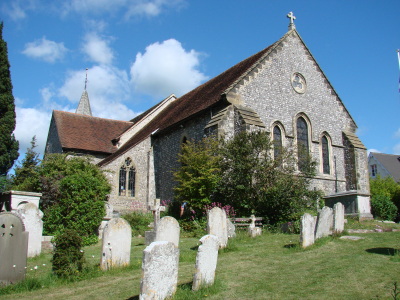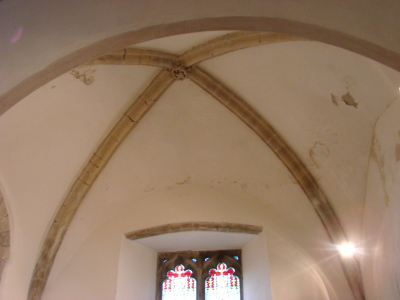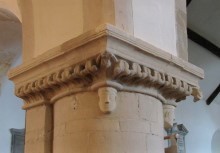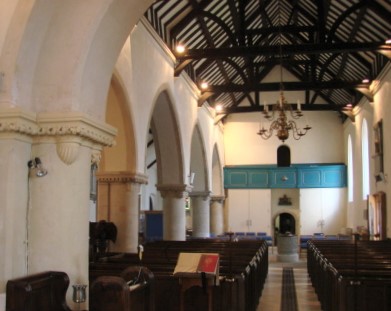Lewes – St Anne, High Street
The tower, nave, western chancel and south chapel are early C12. A south aisle and arcade are late C12 and the chancel was lengthened in the C13, when the exterior was modified. There were more changes in the C15 and C16 and a good C12 font.
St Anne’s was probably always the largest church in Lewes, although in the Middle Ages it was a subsidiary chapel of St Peter Westout whilst the area it served was quite small and except for the eastern part of the chancel lay outside the borough boundaries (2 p13). It was originally dedicated to St Mary and the change may have come about because of a nearby holy well (wells were associated with St Anne (Brent: Pre-Georgian Lewes p114)). There is quite a lot of evidence that there was indeed a well on what is now the north side of Western Road outside the church (Parsons and Milner-Gulland p126) and, more speculatively, the unusual size of the church may result from donations from the many travellers who passed it. There is also some evidence that there was in the church a revered image of the saint (2 p14).
The nave, south chapel off the nave, and western chancel are early C12. The tower of the same period is divided into three stages by string-courses and was never heightened, as the worn fragments of a C12 corbel-table show; the broach spire is probably later. The slightly chamfered entrance from the nave has been much altered, but in essence is likely to be original. Like the bell-openings (only a jamb of the eastern one remains) and north and south windows it is round-headed. A round-headed arch, found in pieces in the blocking of the arch when the west part of the aisle was reinstated in 1927 and now forming the west doorway of the tower, may have been the south doorway (VCH 7 p40).
The nave is also early C12 and was then aisleless, as part of a round-headed window by the outer side of the westernmost arch of the arcade shows. The Burrell Collection drawing shows three similar north ones. There is a tantalising reference (cited in Brent: Georgian Lewes p104) to the repair and resetting of a Norman ‘circular door of entrance’ in 1775. This sounds very much as if it referred to the roll-moulded north doorway with chevrons, now forming the arch of the C19 north porch. It is almost entirely renewed but may incorporate a few fragments of the lost original. The western chancel and south chapel are also early C12, though this is obscured outside by restoration, for instance, the plain round-headed north doorway on the Burrell drawing which is now moulded. The south chapel is in the position of a transept and its date is confirmed by a round-headed east window, found in 1927 (5 p163), and blocked. Although noting the existence of other single transept-chapels in Sussex (e g Aldingbourne, West Sussex), David Parsons (6 p8) speculates on the possibility of a matching north transept but there is no evidence and it seems unlikely. The early C12 arch from the chapel into the nave was adapted shortly before 1200 as the east bay of the arcade added for a new south aisle.
This arch is round-headed; the others of the arcade are pointed and slightly chamfered. However, when incorporated into the arcade, a round pier was inserted, like the others. The capitals have square abaci with a band of stiff leaf; on the lower sides of the angles are pendants of a type found in other C12 churches around Lewes. Some pendants on the older arch are heads or have archaic foliage, but that on the others is near stiff leaf. The bases of the piers are in poor condition, except the western arch, which has water-holding mouldings. Also in the late C12, the chapel vault, with moulded ribs, plain corbels and a small foliage boss, was inserted. Parsons and Milner-Gulland (ibid) suggest two possible reasons for the vault. Either it was inserted because of an intention to construct an upper chamber (which seems unlikely in view of the existence of other vaulted chapels of the same period where there is no suggestion that such a chamber was intended, as at Aldingbourne, or more plausibly because the revered statue of St Anne (see above) was placed there. The chamfered arch to the aisle, though round-headed, is late C12, with grooves on the abaci. On the site of the vestry was the cell of an anchorite, to whom St Richard de Wyche, Bishop of Chichester left five shillings in 1253 (5 p165). He is said to have been interested in anchorites and may have written a treatise of guidance for them (7). The squint, divided by a plain shaft of polished marble, which may not be original. was rediscovered in 1927. It is aligned on a point well short of the present east end, confirming that the chancel was later lengthened.
This squint dates from before the late C13, when a new eastern part was built, almost doubling the length of the chancel (the join is visible in the less restored north wall). The east end has three stepped east lancets, one of them broader, and one to the south. The north ones are renewed and their external roll-mouldings are not apparent on the Burrell drawing, which shows two here, otherwise similar and separated by a C15 window, which is now gone. The rere-arches are also roll-moulded with sills linked by a string-course and the similar rere-arches of the entirely C19 lancets on the north side of the nave suggest that all were inserted then at the same time. Moulded foliage-corbels at the corners of the chancel indicate an intention to vault it; those at the east end are on shafts, but all are remarkably low. However, this was not taken any further, for the roof timbers are mediaeval.
Later mediaeval changes were few and confined to detail. C15 angle-buttresses were added to the tower and the Sharpe Collection (1802-06) and Burrell drawings show further two-light square-headed windows in the nave, also now gone. A longer south one in the chapel with pierced spandrels, though renewed, is like one on the Sharpe drawing. There were C16 alterations, probably after 1538, when St Anne’s became the main church for the whole parish, including St Peter Westout. The most obvious of these were the nave roof with braced queenposts and the old timbers of the aisle roof. The western bay of the aisle may have been removed then, for in 1927 traces of an apparently C16 window were found in the blocking of the arch (5 p161).
Changes between the later C16 and the early C20 were variably documented. The chancel is said to have been repaired in 1750 after it collapsed (Brent: Georgian Lewes p151) though the amount of obviously older material still present suggests the damage was not too great. At the west end there remains a gallery with a panelled front which looks late C18, though altered, and Sir Stephen Glynne in 1826 records a plain, round-headed chancel arch, which from his description does not sound C12 (SRS 101 p177) and perhaps dated from the 1750 repairs. Many windows were blocked or had been replaced. In 1844 R Joanes re-seated the church (ICBS) and the plan attached to the application shows he did quite a bit of work besides, though he did nothing to the chancel arch. In particular, he added the shallow north porch and may be presumed to have brought the doorway to its present condition, thereby confirming a report in The Ecclesiologist (Aug 1844 p158), and replaced the east wall of the chancel, including the three lancets. The insensitively placed brick chimney on the south side of the tower could also be his doing originally, though the present one looks more recent. Unlike the buttresses that he certainly added, it is not apparent on the plan. He also built a vestry on the site of the lost west bay of the south aisle (6 ibid).
Though quite low, the pews in the nave have doors and are more likely to be those that Joanes installed than to date from a further restoration in 1889 by an unknown hand (ESRO Par 411/4/1/1). At that time Joanes’s vestry was enlarged and most of the remainder of the exterior of the church was renewed, though the only change inside was a new chancel arch, still round-headed and derived in style from the south arcade. In 1927 W H Godfrey reinstated the western bay of the aisle, reduced the depth of the west gallery and added a vestry to the south of the chancel to replace that by Joanes. This vestry covers the tomb of M A Lower, the historian of Sussex (4 p284), though the entrance to the vault is marked by a stone in the floor. Bones found on the site of the cell were thought to be those of the anchorite and were re-interred in the chancel (5 p167).
Fittings and monuments
Altar rails: (Both chancel and chapel) Simple C18.
Brass: Unadorned brass inscriptions are not normally noted here, but that to James Cranston (d1790) (pier of south arcade) and others in his family (the latest died in 1808) is an exception, since brasses hardly existed at this time. The lettering is characteristic of the date and it is in two parts, the lower of which is signed ‘Holman, Lewes’.
Figure: (South east corner of nave). St Anne and St Mary by K Jonzen, 1990 (BE(E) p509).
Font: Early C12, tub-shaped, covered in a basket-weave pattern with a rope-moulding below and a band of pellets above. It is similar to that at Denton but is more restored. That similarity argues against the suggestion of Dr Freda Anderson that this was not originally a font, but rather a capital from Lewes priory that was later hollowed out (quoted in www.crsbi.ac.uk retrieved 8/4/2013).
Glass:
1. (East window) O’Connor and Taylor, 1870-73 (www.stainedglassrecords.org) retrieved 11/3/2013). the glass was successfully restored in 2000 (BE(E) ibid).
2. (South chancel, first window) J Powell and Sons, 1883 (BN 45 p909); designed by C Hardgrave (Hadley list).
3. (South chancel, second window) J Powell and Sons, 1872, consists of quarries (Cash book)
4. (South chapel, south window) J B Capronnier, 1889 (signed). A late work with more muted colours than usual in his work.
5. (North nave, first window) J Powell and Sons, 1907 (Order book).
6. (North nave, second window) M Esplin, c1913 (CDG Jan 1915) and very much in the Arts and Crafts idiom.
7. (South aisle, first to third and west windows) J Jacob, c1920-29 (the second one signed).
8. North chancel, first to third windows) Goddard and Gibbs, designed by A E Buss, 1987. (www.stainedglassrecords.org retrieved 11/3/2013); figures and emblems set in plain glass. These replace three worn lancets of 1876 in memory of M A Lower.
Monuments:
1. (North chancel) Restored C14 tomb-recess with a cusped head, ogee-gable and pinnacles. The arcaded tomb-chest with a marble top does not belong and Glynne saw vestiges of a brass on it. Godfrey suggests this is an amalgam of two monuments brought from St Peter Westout (Lewes p38).
2. (South Aisle) Maurice Pearce (d1923) architectural in form by Bournemouth School of Art (BE(E) ibid).
Piscina: (South chapel) Much renewed with a trefoiled head.
Pulpit: Paid for out of a bequest by Harbert Springett (d1622), a prominent Puritan (Brent p296), whose memorial is to be found at Ringmer. Finely carved, with pilasters, though it has almost certainly been cut down.
Royal Arms: (Over entrance to tower) George IV. Small and carved in a rather naive manner.
Sources
1. Anon: St Anne’s Church, Lewes, SNQ 1 (Nov 1927) pp251-52
2. C Brent: The Twinned Mysteries of St Anne’s Church in Lewes, NFSHCT 2010 pp 12-13
3. and J Brent: The Dedication of St Anne’s Church, Lewes, SAC 131 (1993) pp200-01
4. W H Godfrey: St Anne’s Church, Lewes, SAC 68 (1927) p284
5. : Church of St Anne, Lewes, SAC 69 (1928) pp159-69
6. D Parsons: Lewes St Anne – The Structural Development of the Church, NFSHCT 2010 pp 7-11
7. Pamela, Lady Wedgwood: The Anchoress’s Cell at St Anne’s, Lewes, NFSHCT 2010 p16
Plan
Measured plan in VCH 7 p39







